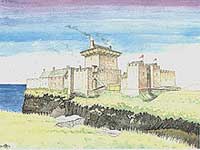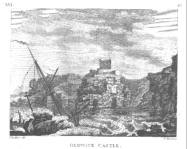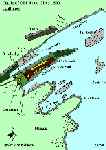 | Introduction | The Castles | Images | Links | History Of Caithness | Glossary | A to Z of Caithness |
• Reconstruction Paintings • Ground Plans • Area Plans • Photo Galleries • Non-Caithness Castles Paintings |
|
Old Wick Castle, Caithness Old Wick Castle Photo Gallery 22 July
03 Introduction
This “artistic reconstruction” shows how the castle would have looked in the late 1500’s. It was painted by Andrew Spratt who used recent photographs of the castle site as a template to superimpose the original foundation plan of the castle - effectively rebuilding it section by section.
The whole site beyond the second ditch was protected by a defensive barmkin wall, which enclosed the keep and also formed the outer wall of the buildings to the rear. The foundations of these buildings can still be seen today. The barmkin also formed an enclosure at the head of the peninsula, which may have been used for growing vegetables or as a courtyard. The formidable approach to the castle was by way of a drawbridge over a broad ditch cut into the rock. A substantial gatehouse and outer wall protected the drawbridge and ditch. The gatehouse permitted access to an outer ward, which may also have contained stables and a smiddy. Access to the inner ward of the castle was across a second ditch by drawbridge, with machicolation above. An efficient design indeed, with any attackers gaining access through the gatehouse, being easily disposed of in the outer ward from the battlements and hoarding. The Castle of Old Wick was one of the numerous strongholds of Sir Reginald de Cheyne who occupied it in the earlier part of the 14th century. Upon his death around 1345 it passed to the Earl of Sutherland by virtue of his marriage to Sir Reginald’s daughter. The Oliphants, Sutherlands of Duffus, Glenorchy and Dunbars of Hempriggs subsequently owned it until it was abandoned in the 18th century. There is little doubt that this castle site is one of the oldest in Caithness and there is evidence to suggest that the ancient earls of the Norse line occupied defensive fortifications here 800 years ago. References:
Also See: |










